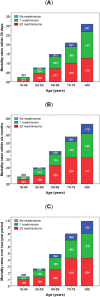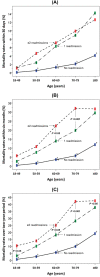Early emergency readmission frequency as an indicator of short-, medium- and long-term mortality post-discharge from hospital
- PMID: 33367951
- PMCID: PMC8354916
- DOI: 10.1007/s11739-020-02599-3
Early emergency readmission frequency as an indicator of short-, medium- and long-term mortality post-discharge from hospital
Abstract
Frequent emergency readmissions, an indicator of quality of care, has been rising in England but the underlying reasons remain unclear. We examined the association of early readmissions with subsequent mortality in adults, taking into account the underlying presenting diagnoses and hospital length of stay (LOS). Data of alive-discharge episodes were prospectively collected between 01/04/2017 and 31/03/2019 in an National Health Service hospital, comprising 32,270 patients (46.1% men) aged 18-107 years (mean = 64.0, ± SD = 20.5 years). The associations of readmission frequency within 28 days of discharge and mortality within 30 days and 6 months of hospital discharge, and over a 2-year period were evaluated, adjusted for presenting diagnoses, LOS, age and sex during the first admission. Analysis of all patients 18-107 years (reference: no readmission) showed mortality within 30 days was increased for 1 readmission: event rate = 9.2%, odds ratio (OR) = 3.4 (95% confidence interval (CI) = 2.9-4.0), and ≥ 2 readmissions: event rate = 10.0%, OR = 2.6 (95%CI = 2.0-3.3), and within 6 months for 1 readmission: event rate = 19.6%, OR = 3.0 (95%CI = 2.7-3.4), and ≥ 2 readmissions: event rate = 27.4%, OR = 3.4 (95%CI = 2.9-4.0), and over a 2-year period for 1 readmission: event rate = 25.5%, hazard ratio = 2.2 (95%CI = 2.0-2.4), and ≥ 2 readmissions: event rate = 36.1%, hazard ratio = 2.5 (95%CI = 2.2-2.8). Within the age groups 18-49, 50-59, 60-69, 70-79 and ≥ 80 years, readmissions were also associated with increased risk of mortality within 3 months and 6 months of discharge, and over 2-year period. In conclusion, early hospital readmission predicts short-, medium- and long-term mortality post-discharge from hospital in adults aged 18-107 years, independent of underlying presenting conditions, LOS, age and sex. Further research focussing on safe discharge and follow-up patient care may help reduce preventable readmissions and post-discharge mortality.
Keywords: Health economics; Healthcare services; Quality of care; Readmission prevention.
© 2020. The Author(s).
Conflict of interest statement
The authors declare that they have no conflicts of interest.
Figures



Similar articles
-
Evaluation of the association of length of stay in hospital and outcomes.Int J Qual Health Care. 2022 May 2;34(2):mzab160. doi: 10.1093/intqhc/mzab160. Int J Qual Health Care. 2022. PMID: 34918090 Free PMC article.
-
Variation in Facility-Level Rates of All-Cause and Potentially Preventable 30-Day Hospital Readmissions Among Medicare Fee-for-Service Beneficiaries After Discharge From Postacute Inpatient Rehabilitation.JAMA Netw Open. 2019 Dec 2;2(12):e1917559. doi: 10.1001/jamanetworkopen.2019.17559. JAMA Netw Open. 2019. PMID: 31834398 Free PMC article.
-
Readmissions Within 48 Hours of Discharge: Reasons, Risk Factors, and Potential Improvements.Dis Colon Rectum. 2020 Aug;63(8):1142-1150. doi: 10.1097/DCR.0000000000001652. Dis Colon Rectum. 2020. PMID: 32692075
-
Hospital readmissions and post-discharge all-cause mortality in COVID-19 recovered patients; A systematic review and meta-analysis.Am J Emerg Med. 2022 Jan;51:267-279. doi: 10.1016/j.ajem.2021.10.059. Epub 2021 Nov 6. Am J Emerg Med. 2022. PMID: 34781153 Free PMC article.
-
Hospital readmissions and emergency department re-presentation of COVID-19 patients: a systematic review.Rev Panam Salud Publica. 2022 Oct 10;46:e142. doi: 10.26633/RPSP.2022.142. eCollection 2022. Rev Panam Salud Publica. 2022. PMID: 36245904 Free PMC article. Review.
Cited by
-
Association of Paroxysmal Versus Persistent Atrial Fibrillation with In-hospital Outcomes and 30-day Readmission After Inpatient Atrial Fibrillation Ablation.J Innov Card Rhythm Manag. 2024 Jun 15;15(6):5894-5901. doi: 10.19102/icrm.2024.15066. eCollection 2024 Jun. J Innov Card Rhythm Manag. 2024. PMID: 38948660 Free PMC article.
-
MAIT cell counts are associated with the risk of hospitalization in COPD.Respir Res. 2022 May 18;23(1):127. doi: 10.1186/s12931-022-02045-2. Respir Res. 2022. PMID: 35585629 Free PMC article.
-
Perioperative outcomes of esophagectomy after doublet versus docetaxel-based triplet neoadjuvant chemotherapy in older patients: A nationwide inpatient database study in Japan.Ann Gastroenterol Surg. 2025 Feb 5;9(4):687-697. doi: 10.1002/ags3.70000. eCollection 2025 Jul. Ann Gastroenterol Surg. 2025. PMID: 40607291 Free PMC article.
-
The Effect of Recurrent Heart Failure Hospitalizations on the Risk of Cardiovascular and all-Cause Mortality: a Systematic Review and Meta-Analysis.Curr Cardiol Rep. 2024 Oct;26(10):1113-1122. doi: 10.1007/s11886-024-02112-8. Epub 2024 Sep 4. Curr Cardiol Rep. 2024. PMID: 39230619
-
Frequent users of health services among community-based older Australians: Characteristics and association with mortality.Australas J Ageing. 2022 Dec;41(4):e328-e338. doi: 10.1111/ajag.13110. Epub 2022 Jun 27. Australas J Ageing. 2022. PMID: 35761510 Free PMC article.
References
-
- Healthwatch (2018) Emergency readmissions: what's changed one year on? https://www.healthwatch.co.uk/report/2018-11-14/emergency-readmissions-w.... Accessed 15 Nov 2020
MeSH terms
LinkOut - more resources
Full Text Sources

